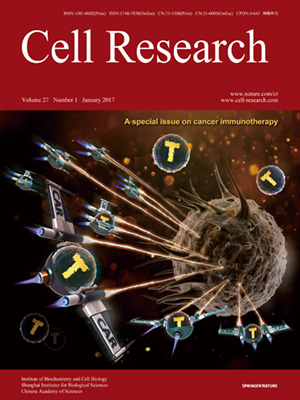
Volume 27, No 1, Jan 2017
ISSN: 1001-0602
EISSN: 1748-7838 2018
impact factor 17.848*
(Clarivate Analytics, 2019)
Volume 27 Issue 1, January 2017: 154-157
LETTERS TO THE EDITOR
CRISPR-Cas9-mediated multiplex gene editing in CAR-T cells
Xiaojuan Liu1,*, Yongping Zhang2,*, Chen Cheng1,3,*, Albert W Cheng4, Xingying Zhang1,5, Na Li1, Changqing Xia2,6, Xiaofei Wei7, Xiang Liu1 and Haoyi Wang1,5,8
1State Key Laboratory of Stem Cell and Reproductive Biology, Institute of Zoology, The Chinese Academy of Sciences, Beijing, China
2Department of Hematology, Xuanwu Hospital, Capital Medical University, Beijing, China
3Graduate School, University of Science and Technology of China, Hefei, China
4The Jackson Laboratory for Genome Medicine, Farmington, CN, USA
5University of Chinese Academy of Sciences
6Department of Pathology, Immunology and Laboratory Medicine, University of Florida, FL, USA
7Beijing Cord Blood Bank, Beijing, China
8The Jackson Laboratory, Bar Harbor, ME, USA
Correspondence: Haoyi Wang,(wanghaoyi@ioz.ac.cn)
Chimeric antigen receptor (CAR) T cell therapy is a promising approach to treat cancer, such as B-cell malignancy1. However, the current standard treatment requires autologous adoptive cell transfer, which is expensive and time-consuming. For newborn and elder patients, it is often difficult to obtain enough T cells with good quality to generate patient-specific CAR-T cells. To make CAR-T therapy more accessible, it is highly desirable to develop an allogeneic adoptive transfer strategy, in which universal CAR-T cells derived from T cells from healthy donors can be applied to treat multiple patients. For this strategy to work, the αβ T-cell receptor (TCR) on allogeneic CAR-T cells needs to be eliminated to avoid graft-versus-host-disease (GVHD), and human leukocyte antigens class I (HLA-Is) on CAR-T cells need to be removed to minimize their immunogenicity. Previous studies have shown that mutation in TCRα subunit constant (TRAC) leads to loss of αβ TCR on T-cell surface2, and beta-2 microglobulin (B2M) is essential for cell-surface expression of HLA-I heterodimers3.
10.1038/cr.2016.142
FULL TEXT | PDF
Browse 4077


